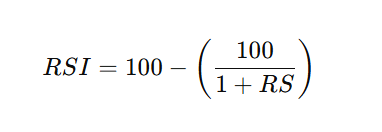In the world of stock trading, understanding technical indicators can give investors a significant edge. Two of the most widely used indicators are the Relative Strength Index (RSI) and the Exponential Moving Average (EMA). These indicators provide valuable insights into stock trends, momentum, and potential entry or exit points. Whether you’re a beginner or an experienced trader, incorporating RSI and EMA into your strategy can elevate your trading game.
In this blog, we’ll explore the RSI and EMA, their formulas, how to use them, and their relevance in making sound trading decisions.
What Is RSI (Relative Strength Index)?
The Relative Strength Index (RSI) is a momentum oscillator that measures the speed and change of price movements. RSI helps traders identify overbought or oversold conditions in a stock, which can signal potential reversals or trend continuations.
Formula for RSI:

Where:
- RS (Relative Strength) = Average gain of up periods during a specified time / Average loss of down periods during the same time
RSI values range between 0 and 100.
How RSI Works
- Overbought Condition (RSI > 70):
- When RSI crosses 70, it indicates that the stock might be overbought, suggesting a possible price correction.
- Example: If a stock’s RSI reaches 80, traders might consider selling.
- Oversold Condition (RSI < 30):
- When RSI falls below 30, it indicates oversold conditions, hinting at a possible rebound.
- Example: If RSI is at 20, it could be an excellent buying opportunity.
Advantages of RSI:
- Identifies Momentum: Quickly shows whether the stock is gaining or losing strength.
- Trend Reversal Signals: Highlights potential reversal points.
- Easy Interpretation: RSI values are straightforward to understand.
How to Use RSI in Trading
Divergence Signals:
- Bullish Divergence: When the stock price is falling but RSI is rising, it indicates a potential reversal.
- Bearish Divergence: When the stock price is rising but RSI is falling, it suggests a possible downtrend.
Overbought and Oversold Levels:
- Use RSI levels (70 and 30) to determine entry and exit points.
Combination with Other Indicators:
-
- Pair RSI with EMA for better accuracy.
What Is EMA (Exponential Moving Average)?
The Exponential Moving Average (EMA) is a trend-following indicator that gives more weight to recent price data. Unlike the simple moving average (SMA), EMA reacts more quickly to price changes, making it ideal for fast-moving markets.
Formula for EMA:
Where:
- P_t = Current price
- n = Number of periods
How EMA Works:
- Short-Term EMA (e.g., 9-day EMA):
- Reacts quickly to price changes, useful for short-term traders.
- Long-Term EMA (e.g., 50-day EMA):
- Provides a smoother view of the trend, ideal for long-term investors.
Advantages of EMA:
- Responsive to Price Changes: More sensitive than SMA.
- Tracks Trends Efficiently: Highlights long-term and short-term trends.
- Combines Well with Other Indicators: Works effectively with RSI for identifying trends and reversals.
How to Use EMA in Trading
- Golden Cross and Death Cross:
- Golden Cross: When the short-term EMA crosses above the long-term EMA, it signals a bullish trend.
- Death Cross: When the short-term EMA crosses below the long-term EMA, it signals a bearish trend.
- Trend Confirmation:
- EMA acts as a support or resistance level during trends.
- Entry and Exit Signals:
- Use EMA crossovers to time your trades effectively.
RSI and EMA Together: A Powerful Combination
Combining RSI and EMA can provide more robust trading signals. While RSI identifies overbought or oversold conditions, EMA confirms the trend direction.
How to Use RSI and EMA Together:
- Buy Signal:
- RSI is below 30 (oversold), and the price crosses above the EMA.
- Sell Signal:
- RSI is above 70 (overbought), and the price crosses below the EMA.
- Trend Confirmation:
- Use EMA to confirm RSI signals.
Examples of RSI and EMA in Action
Scenario 1: Bullish Trade
- A stock has an RSI of 25, indicating it’s oversold.
- The price breaks above the 50-day EMA, confirming an uptrend.
- Action: Enter a long trade and hold until RSI nears 70.
Scenario 2: Bearish Trade
- A stock has an RSI of 75, signaling it’s overbought.
- The price falls below the 20-day EMA, confirming a downtrend.
- Action: Enter a short trade and hold until RSI nears 30.
Benefits of Using RSI and EMA
- Accurate Entry and Exit Points:
- Combines momentum and trend analysis.
- Reduces False Signals:
- EMA filters out noise in RSI signals.
- Versatile:
- Can be used for intraday, swing, or long-term trading.
Conclusion
The RSI and EMA indicators are essential tools for stock market analysis. While RSI helps identify overbought or oversold conditions, EMA provides a clear picture of the trend. Together, they create a powerful combination that can improve your trading strategy. By mastering these indicators, you can make more informed decisions and achieve greater success in the stock market.
Use these tools wisely, practice on historical data, and develop a disciplined approach to trading. Remember, the stock market rewards those who stay informed and patient.